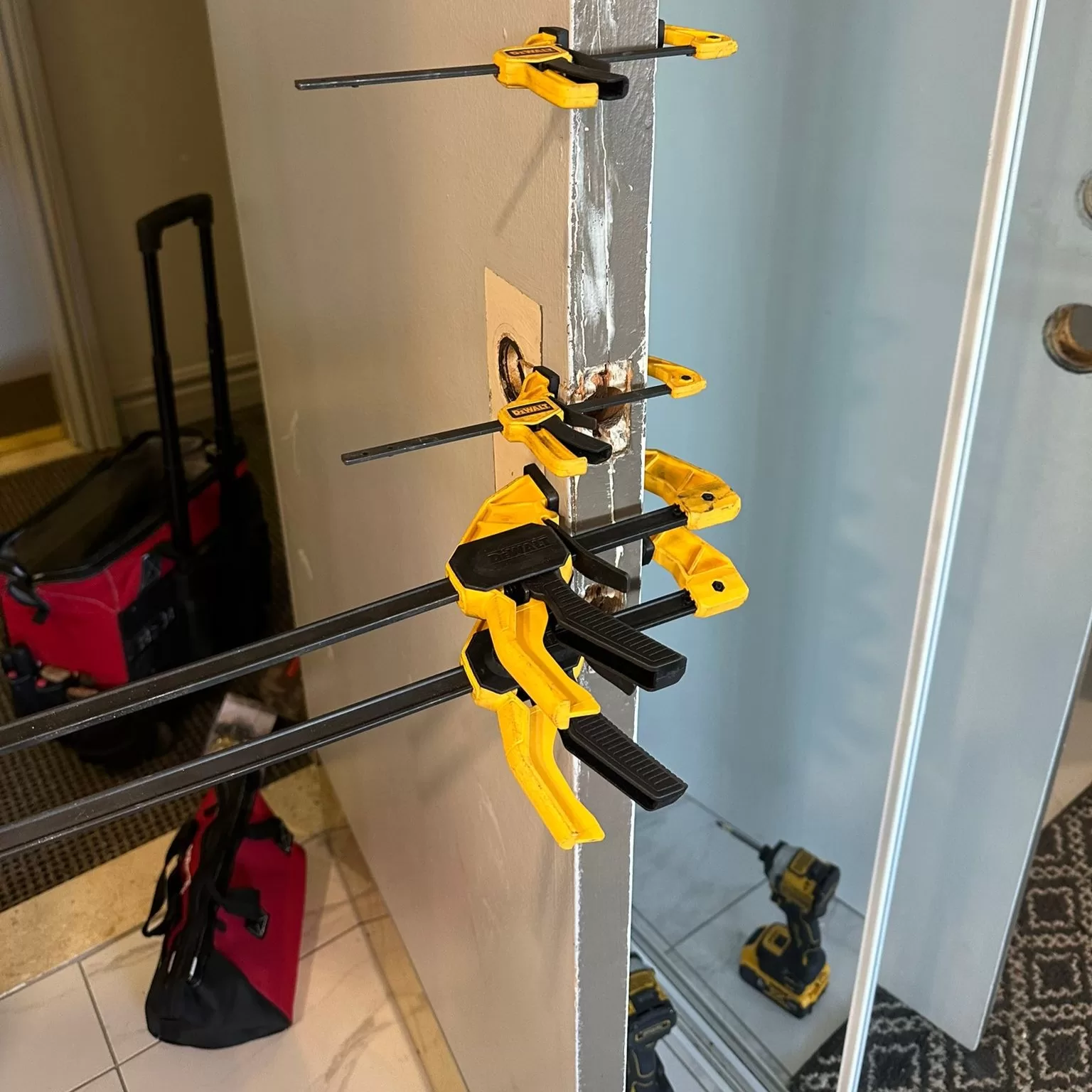Materials You’ll Need
- Wood Filler or Wood putty: is best for repairing cracks and small holes in wooden doors.
- Clamps: Use bar clamps or C-clamps to hold the split together during the repair process.
- Screwdriver: To remove any hardware or screws.
- Sanding paper: For smoothing out the repaired area.
- Paint or wood finish: To touch up the door’s appearance once the repair is complete.
Step 1: Identify the Extent of the Damage
Before jumping into the repair, take a close look at the crack or split to determine the severity of the damage. Minor splits are easy to repair using wood filler or glue, but deeper or longer cracks may require more intensive repairs. If you’re unsure about the extent of the damage, feel free to call us for a 100% free estimate at (647) 371-5756, and we’ll help you assess the situation.
Step 2: Remove Hardware
Remove any hardware, like doorknobs, locks, and hinges, from the door to access the split easily.
Step 3: Clean the Area
Clean the split area to remove any dirt, dust, or debris. A clean surface ensures better adhesion of the wood glue and the wood filler.
Step 4: Apply Wood Filler or Wood Glue
If the door is cracked or if there is a missing part of the wood: apply a generous amount of wood filler to the crack, making sure it completely fills the gap.
Begin by using a putty knife to scoop the filler into the cracks. This tool allows you to reach the deep, impacted areas of the door, ensuring a thorough repair. Start with a small amount of filler, pressing it into the inside ridges of each crack. This technique helps cover the entire surface area effectively.
Continue adding more filler incrementally until the material slightly protrudes past the door’s surface. This ensures that the crack is entirely filled and ready for any necessary sanding or finishing touches later on. With these steps, you can achieve a smooth and seamless repair that maintains the door’s integrity.
Step 5: Clamp the Split in the Door
Use clamps to hold the split door together while the wood filler dries, but be cautious not to over-tighten them, as this could potentially cause the door to warp. (You can skip this step if your door is cracked and you’ve used wood filler).
Step 6: Sand and Finish
Once the wood filler has fully dried and the split/crack is securely mended, sand the repaired area to make it smooth. This ensures a seamless look and prepares the surface for finishing.
After sanding, apply paint or a wood finish to match the door’s finish. You can opt for a paint that matches the existing color of the door or choose a new palette for a fresh look. For a consistent and polished appearance, consider repainting the entire door. This not only harmonizes the repaired area with the rest of the surface but also allows for multiple solid layers, enhancing durability and richness.
Remember, applying multiple coats not only perfects the color but also provides extra protection, ensuring your door looks pristine for years to come.
How to Repair Large Door Cracks Using a Wood Spline
Dealing with sizable cracks in a wooden door can seem challenging, but using a wood spline can make the repair process more efficient and effective. Here’s a step-by-step guide on how to tackle this issue:
- Prepare the Crack: Begin by enlarging the crack slightly to ensure the wood spline fits snugly. Use a durable tool like a Dremel to carefully widen the gap.
- Fit the Wood Spline: Insert the wood spline into the expanded crack. If necessary, use a mallet or hammer to gently tap it into place, ensuring a tight fit. This provides a stable base for the glue.
- Apply Wood Glue: Once the spline is securely positioned, fill any remaining spaces around it with quality wood glue. This combination creates a solid repair that helps restore the door’s integrity.
- Finish the Surface: Allow the glue to dry thoroughly. Then, sand down the spline so it aligns perfectly with the door’s surface. This step ensures a smooth and even finish.
- Repaint or Stain: After sanding, repaint or stain the repaired area to blend it seamlessly with the rest of the door.
Utilizing a wood spline not only reinforces the repair but also ensures a longer-lasting solution for large door cracks.
Using Epoxy Glue to Repair Medium-Sized Door Cracks
Epoxy glue is your go-to solution for effectively repairing medium-sized cracks in your door. Here’s how you can use it to restore your door to its former glory:
- Prepare the Crack: Start by thoroughly cleaning the crack to ensure it’s free from dust and debris. This is crucial for the epoxy to adhere properly.
- Apply the Epoxy: Carefully apply the epoxy glue along the inner edges of the crack. A little goes a long way, as the glue will expand to fill the damaged area.
- Layering: After the initial application, wait for the glue to dry completely. Once dry, add another layer to make sure the crack is fully filled up to the surface of the door.
- Smoothen the Surface: Once the final layer dries, use fine-grit sandpaper to sand down the excess glue. This will ensure the repaired area is smooth and level with the rest of the door.
By following these steps, epoxy glue will not only fill but also reinforce the cracked area, offering a durable repair solution for your door.
How to Choose Between Wood Putty and Filler for Door Repair
When you’re faced with fixing a cracked door, the choice between wood putty and wood filler is crucial for a seamless repair. Let’s explore how to decide the best option for your specific needs.
Consider the Door’s Finish
- Painted Doors: If your door is painted, wood filler is the ideal choice. Filler dries hard, allowing you to sand it down smoothly. Once sanded, you can repaint the door to match the original color, ensuring the repair blends seamlessly with the rest of your home decor.
- Stained or Natural Finish: If the door is stained or has a natural wood finish, wood putty might be the better option. Its flexibility works well for minor blemishes, as it doesn’t dry hard like filler. Simply fill the crack and smooth it out to match the surrounding finish.
Evaluate the Size of the Damage
- Minor Damages: For small, less noticeable cracks or blemishes, wood putty is a quick and easy solution. Its soft, pliable nature makes application a breeze, and it requires minimal effort to blend with existing textures.
- Larger Cracks: For more significant cracks or gaps, opt for wood filler. Its durability ensures a long-lasting repair. Once applied, the filler hardens, providing a sturdy surface ready for sanding and finishing.
Understand the Material Properties
- Flexibility: Wood putty remains flexible even after application, making it suitable for minor imperfections. However, because it doesn’t harden completely, it’s not recommended for structural repairs.
- Durability: Wood filler hardens completely, making it perfect for areas that require more robust repair. Once sanded, the surface can be painted or stained to match your door’s original aesthetic.
By assessing your door’s finish, the extent of the damage, and understanding the material properties, you can make an informed choice that ensures your door repair is both effective and visually appealing. Additionally, it’s important to gather the right tools and materials before starting the repair process. Researching methods on how to fix an exterior door can provide valuable insights and techniques to achieve the best results. By combining your assessment with expert advice, you’ll ensure that your door is not only restored to its former glory but also durable against future wear and tear.
How Long Should I Wait for Wood Filler to Dry on a Door Crack?
The time required for wood filler to dry can vary, and it largely depends on the type of filler you’re using. Here’s a quick guide to help you figure out the ideal waiting period:
- Water-Based Fillers: These typically dry faster, often within 30 minutes to an hour. However, it’s wise to allow extra time, particularly in humid conditions.
- Solvent-Based Fillers: Known for their durability, these fillers usually take longer to dry, often requiring two to six hours. Higher humidity levels can also extend this time.
- Epoxy Fillers: While incredibly strong, epoxy fillers can have variable drying times, ranging from several hours to overnight, depending on the brand and application thickness.
To ensure your filler is ready for the next step, check for a firm texture that doesn’t give when lightly pressed. It’s better to allow more time than to rush the process and risk compromising the finish.
When to Call a Professional
While repairing a split wood door can be an easy DIY project, there are situations when it’s best to seek the expertise of a professional:
- Extensive Damage: If the split is too extensive or the door is severely warped, a professional can assess whether it’s salvageable or needs replacement.
- Structural Issues: If the door’s frame or hinges are affected, a professional door repair company can address these issues correctly.
- Historical or Valuable Doors: Antique or valuable doors require special care and expertise to preserve their authenticity and value.
- Lack of DIY Experience: If you’re unsure about your DIY skills or don’t have the necessary tools, it’s safer to rely on professionals to avoid causing further damage.
Exploring Replacement Options
If repairs become too difficult or costly, consider replacing your door entirely. This can be a practical solution, especially if you’re looking to enhance your home’s curb appeal or improve energy efficiency. Here’s how you can proceed:
- Consultation Services: Many companies offer free consultations to help you choose a door that matches your home’s style and budget. This can be an invaluable step in ensuring that your new door complements your existing decor while meeting functional needs.
- Wide Selection of Styles: From sleek modern designs to classic wooden doors, the options are vast. A professional can guide you through materials and styles that best suit your climate and personal taste.
- Professional Installation: Choosing to replace your door doesn’t just end with selection. Professional installation ensures that your new door is fitted correctly, providing security and energy efficiency for years to come.
By weighing these options, you can make an informed decision about whether to repair or replace your door, ensuring both functionality and style for your home.
In conclusion, repairing a split wood door is possible with the right tools and techniques for small splits and cracks. However, for extensive damage or valuable doors, it’s advisable to consult a professional woodworking or door repair company. They can provide expert solutions that ensure your door’s long-term durability and aesthetics.



